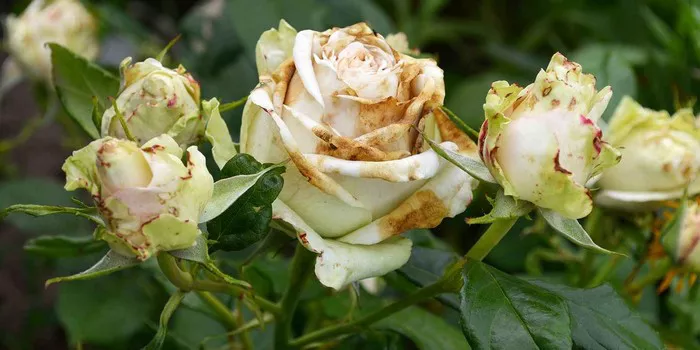Botrytis, commonly known as gray mold, is a fungal disease that affects a wide range of plants, including flowers. This disease can lead to devastating losses in the floral industry, causing significant economic and aesthetic damage. Understanding the causes of Botrytis is crucial for implementing effective prevention and control measures. In this article, we delve into the precise factors that contribute to the development of Botrytis in flowers and explore strategies to mitigate its impact.
What is Botrytis?
Botrytis cinerea, the fungus responsible for Botrytis, thrives in cool, humid conditions, making it particularly problematic in greenhouse environments and during periods of high moisture. This fungus is capable of infecting various plant parts, including flowers, stems, leaves, and fruits. In flowers, Botrytis manifests as characteristic grayish-brown lesions, often accompanied by a fuzzy gray mold growth, ultimately leading to tissue decay and plant death if left unchecked.
Precise Causes of Botrytis in Flowers
1. Environmental Conditions: Botrytis thrives in environments with high humidity and moderate temperatures, typically ranging between 15°C to 25°C (59°F to 77°F). These conditions are commonly found in greenhouses, especially during periods of poor ventilation or when plants are densely packed together. Additionally, extended periods of leaf wetness due to overhead irrigation or condensation can create ideal conditions for Botrytis development.
2. Plant Injury or Stress: Plants that have been mechanically damaged, such as through pruning or handling, are more susceptible to Botrytis infection. Wounds provide entry points for the fungus, facilitating its colonization of plant tissues. Furthermore, stressed plants, whether due to nutritional deficiencies, water stress, or pest infestations, exhibit weakened immune responses, making them more vulnerable to Botrytis and other pathogens.
3. Overcrowding and Poor Air Circulation: Dense plant canopies restrict air movement, creating microclimates conducive to Botrytis growth. In greenhouses or tightly packed garden beds, inadequate air circulation prolongs leaf wetness and increases humidity around plants, creating an environment favorable for fungal spore germination and disease spread.
4. Contaminated Plant Material: Botrytis can spread through infected plant debris, such as fallen petals, leaves, or stems, left on the ground or within the plant canopy. Spores produced by decaying plant material serve as inoculum sources, capable of initiating new infections when conditions are favorable. Proper sanitation practices, including the removal and disposal of diseased plant debris, are essential for minimizing Botrytis spread.
5. Fungal Spore Dispersal: Botrytis produces abundant airborne spores that can travel short distances within the greenhouse or garden environment. These spores are carried by air currents, water droplets, or even insects, facilitating the spread of the fungus from infected to healthy plant tissues. Once deposited on susceptible plant surfaces, spores germinate under favorable conditions, initiating new infections and perpetuating the disease cycle.
6. Cultural Practices: Certain cultural practices, such as excessive overhead irrigation or improper fertilization, can inadvertently promote Botrytis development. Overhead irrigation systems that wet foliage increase leaf moisture and create an environment conducive to fungal spore germination. Likewise, excessive nitrogen fertilization can result in lush, succulent growth that is more susceptible to Botrytis infection.
Preventive Measures and Management Strategies
1. Maintain Optimal Growing Conditions: Minimize humidity levels and promote good air circulation within the growing environment to discourage Botrytis development. Proper ventilation, spacing between plants, and judicious watering practices help create less favorable conditions for fungal growth.
2. Monitor and Manage Plant Health: Regularly inspect plants for signs of stress, injury, or disease. Promptly address any issues, such as nutrient deficiencies or pest infestations, to maintain plant vigor and resilience against Botrytis and other pathogens.
3. Implement Sanitation Practices: Remove and dispose of diseased plant material to prevent the buildup of inoculum within the growing area. Prune infected plant parts and clean tools thoroughly to avoid spreading the fungus between plants. Additionally, practice weed control to reduce alternative hosts for Botrytis and other pathogens.
4. Utilize Biological Controls: Consider using biological control agents, such as beneficial microorganisms or natural predators of Botrytis, to suppress fungal populations. Biological fungicides containing antagonistic microbes or enzymes that target Botrytis can help reduce disease incidence while minimizing environmental impact.
5. Opt for Resistant Varieties: When feasible, choose plant varieties that exhibit resistance or tolerance to Botrytis infection. Breeding for resistance traits can significantly reduce the risk of disease and lessen the reliance on chemical interventions for disease control.
6. Employ Chemical Controls Prudently: If necessary, apply fungicides labeled for Botrytis control according to manufacturer recommendations and local regulations. Rotate fungicide classes to prevent the development of fungicide resistance in Botrytis populations. Timing applications to coincide with periods of high disease pressure or susceptible growth stages maximizes efficacy while minimizing environmental impact.
7. Practice Integrated Pest Management (IPM): Adopt an integrated approach that combines cultural, biological, and chemical control methods to manage Botrytis and other pests and diseases effectively. IPM strategies aim to minimize reliance on pesticides while maintaining plant health and productivity sustainably.
Conclusion
Botrytis represents a significant challenge for flower growers, with its ability to rapidly spread and cause extensive damage under favorable conditions. By understanding the precise factors contributing to Botrytis development and implementing proactive prevention and management strategies, growers can effectively mitigate the impact of this fungal disease on their crops. Through careful attention to growing conditions, sanitation practices, and the judicious use of cultural and chemical controls, growers can minimize losses and maintain healthy, vibrant flowers for market or enjoyment.


